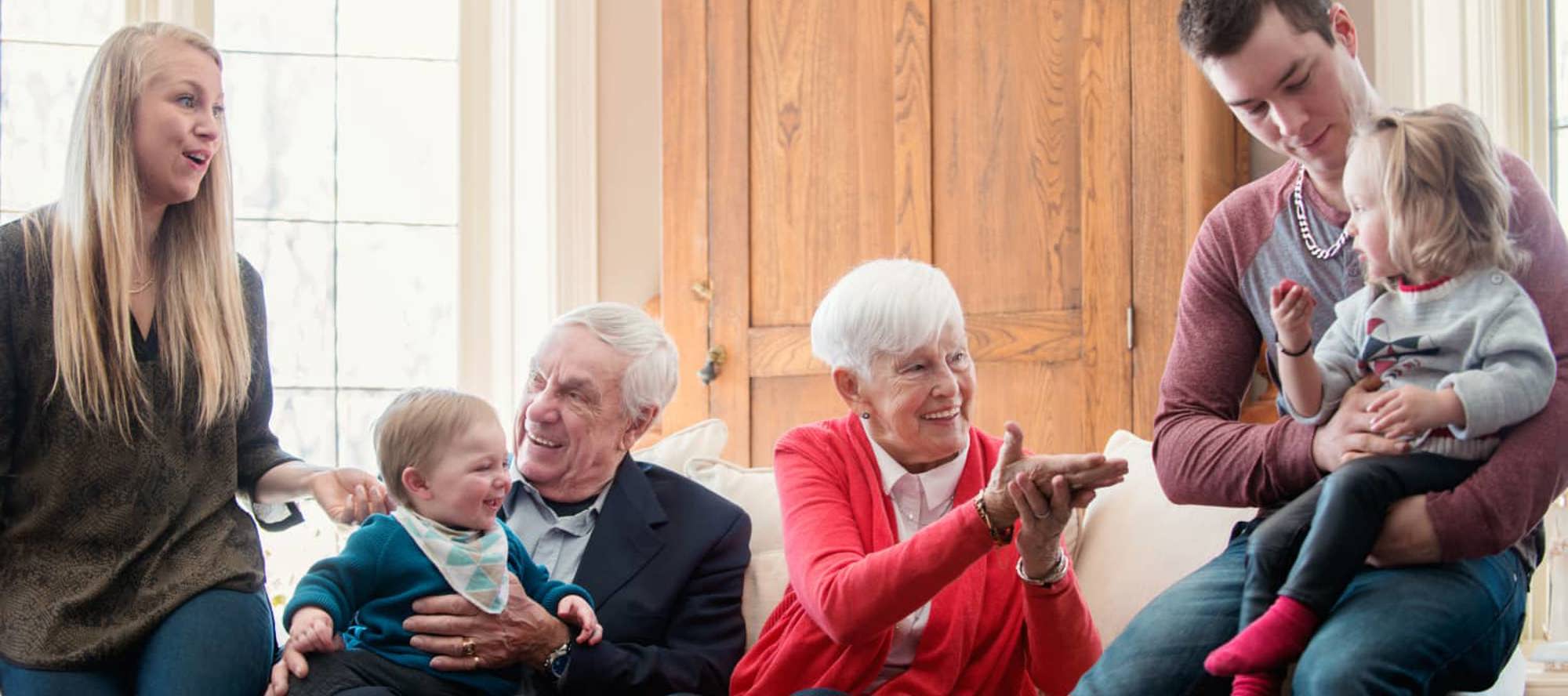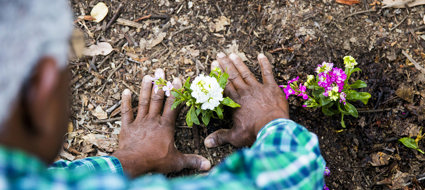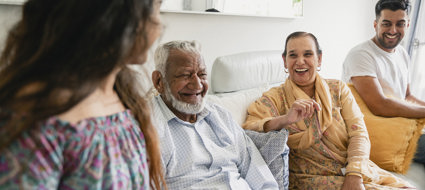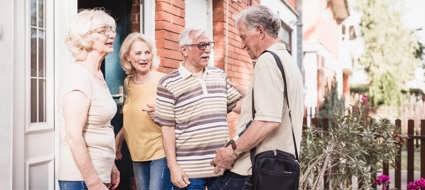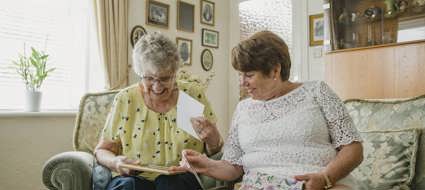Ageing well: Housing options and alternative modes of living for later life - Multi-generational co-housing
Published:
This podcast explores multi-generational co-housing as an alternative housing option in later life, considering how it can reduce loneliness and foster social connectedness, independence and community.
Mary Robson, Research and Development Officer at Research in Practice speaks to Liz about her experience of living at LILAC (Low Impact Living Affordable Community), a multi-generational co-housing project in Leeds.
This conversation offers unique insight into what it’s like to live in multi-generational co-housing, highlighting the untapped potential and opportunities of more innovative and under-utilised models of housing.
[Introduction]
This is a Research in Practice podcast, supporting evidence-informed practice with children and families, young people and adults.
Mary: Hello everyone, and welcome to this Research in Practice podcast. My name is Mary Robson, and I'm a Research and Development Officer. Today in this podcast, we're going to be exploring older people's experiences of specialised and innovative housing models. This builds upon and brings to life our recent evidence review entitled Ageing well – Housing options and alternative modes of living for later life, which can be found on our website. Today, we're going to be exploring co-housing. I'm really delighted to welcome Liz from LILAC (Low Impact Living Affordable Community) co-housing in Leeds. So, welcome, Liz. How are you today?
Liz: I'm fine today, thank you.
Mary: Brilliant.
Liz: I'm just in my flat at LILAC, looking out at the trees and the grass.
Mary: Fantastic. Would you like to just introduce yourself?
Liz: Yes. So, I just turned 70 last week, and I've been living at a co-housing project, which I'll tell you more about in a minute, for the last eight years, where I've got my own flat and my own little allotment, and I've got lots of shared gardens and lots of friendly neighbours.
[LILAC’s approach to co-housing]
Mary: Fantastic. Sounds brilliant. So, I guess if you could just start by telling us a little bit about LILAC. What is LILAC?
Liz: So, LILAC is a co-housing community, which is designed to encourage people to interact with their neighbours. We've got twenty houses and flats, which we had built eight years ago, we moved in, and we formed as a group and worked with an architect to design the buildings once we found the site, and then engaged builders to build them. Yes, as I said, we moved in eight years ago. We run LILAC, it's a co-op, a housing co-op, and that's where I'm very happily living.
Mary: What does LILAC stand for?
Liz: It's got three strands, and the letters stand for Low Impact Living, so that's one of the strands, is about living lightly on the planet, and everything's designed to do that. We live together in ways that save energy, like, say, sharing cars and having a laundry for the washing, so you don't have your own washing machine. So, Low Impact Living, and then Affordable. There was a lot of emphasis, that both the financial model, the way we paid for our houses, and the cost of them when they were built, we were keeping an eye and keeping it affordable so people could get onto the property market. It's designed to remain affordable over time, so people can't be priced out. Then the C is for Community. So, it's very important that we live as a close community who support each other.
Mary: Fantastic, it sounds brilliant. Who lives at LILAC?
Liz: Well, we're 33 adults and 13 children, the oldest is, I think, 86 and the youngest is a baby who was born on 31 July. So, we've got the whole span. Yes, there are several families. The families live in three or four-bedroom houses, most of them, and then there are two and one-bedroom flats, which are more likely to have couples or single people in, but occasionally there are children. There are children living in the flats as well, three-storey flats. The buildings are constructed with straw bales in the walls, so they're very warm, and they're very light. They've got lovely big windows, triple-glazed windows.
Mary: Brilliant, and how are all the, kind of, houses and flats set out? What's the kind of layout of the housing scheme?
Liz: Yes, we were really lucky. We got this L-shaped plot that used to be a primary school, and part of it can't be built on because it's got a main sewer running under it, which meant property developers didn't want it, so we've designed it so there's a pond in the centre that's a sort of feature, where all the drainage water goes, and then around that there are these terraces of three houses, and two blocks of three-storey blocks of flats. Then in the little bit of the L is where the allotments are, and there's a little park that's open to the public up in that corner of the site, where there are a lot of mature trees. In between the pond and the houses, there's lots of shared gardens. There's also, most importantly, a common house, which is like a community centre, and that's where the laundry and the workshop are, and there's the kitchen and dining room where when we're not in COVID, we would have shared meals in there a couple of times a week. There's a big room upstairs where we have meetings and watch films, and the children have sleepovers these days, and there are a couple of offices and guest bedrooms up there.
Mary: Fantastic, so a real sense of community.
Liz: Yes, and it's lovely and leafy and green with lots of fruit trees and bushes. It's very productive, and people walk in and go, 'wow’, because it is like an oasis. It's in the middle of the city but it's really quiet and green.
Mary: Brilliant, and do you grow your own food there as well, and all that?
Liz: Yes. So, every house and flat has got an allotment, and then we've got five allotments that are rented out to people that live in the area, and people try and grow as much food as they can. Not everybody likes doing it, so some people who live here ask someone else to help them with their allotment, or give half of it to a neighbour. Lockdown's been good because people have been at home more, so the allotments are more productive than ever this year.
[Building a co-housing community]
Mary: What was the process like to live at co-housing?
Liz: It took seven years from two couples having an idea that they'd like to build a community and raise their family in a community that was designed on ecological lines and would show it is possible to have a different way of life, where you're less in your own box and more in a community. They had that idea, and then set about forming a group and looking for land, and eventually they found this site with the help of the city council, and got planning permission to build. People joined the project, and when you joined, you paid your deposit on your future home, and that gave some cash, and we also got a grant that helped us. There are grants available these days for community-led housing initiatives. The government are supporting people to do this, through housing associations and through groups like ours forming in community land trusts. So, we slowly developed until all the flats and houses were taken and we had our community. And then for the year that the build took, we worked really hard on developing policies and dreaming about how we were going to live together, and what the boundaries were going to be, and what the expectations were, and in that way really got to know each other, and to think about how we wanted to live. Then finally we all moved in. So, it was seven years. I think I was involved for two-and-a-half years before we moved in, and it was hard work, there's no doubt about it, but satisfying as well.
Mary: What kinds of conversations were you having in that planning stage around what kind of community you wanted to live in?
Liz: Well, everything from what the buildings were going to be made of, and how we wanted them to be as low-carbon as possible, and lots of conversations about what was affordable. In terms of solar panels, were they affordable? Were they cost-effective? So, we had research done about that, but also lots of conversations about how we would use shared space, and what kind of food would be eaten in the common house. A lot of the people that live here are vegetarian and vegan, and that part of having a low impact on the planet, so there were a lot of conversations about how we would manage the kitchen in the common house. We divided ourselves up into groups, which we still have, called task teams. So, everyone who lives here is on a task team. It might be they're on the finance task team, dealing with the collecting the money every month that people pay, and dealing with the banks and that, doing the accounts, or they might be on the landscape team, or the common house team. There are different teams to different aspects of living here. So, yes, that's the finer things we were talking about. I was really involved in the landscape team, and we spent a lot of time looking at the grounds plan, and we had a landscape architect advise us what plant. I was thinking about where we were going to get the plants, and could we get them for nothing? Which we largely did, apart from the big trees that went in. We begged, borrowed and split other gardener friends' plants. So, you can see that some of that was really good fun, and some of it was serious.
Mary: So, well-organised then it sounds, before.
Liz: Yes, and that work that we did in forming our community set us in good stead. We still use those methods now, and we use consensus decision-making, and when there are big decisions to make, we all come together. Part of living in co-housing involves being willing to attend meetings and take your part in the democratic process of running the place, but there are lots of rewards and lots of celebrations and parties, and fun. I must say, the children have the most fantastic life, because we've got a big play area, and they've got lots of space, and they've got a safe neighbourhood where they can run around and scoot and cycle with no danger, no cars on the site. They're in the corners. We've got a couple of car parks, but yes, we keep cars to a minimum and out of site.
Mary: Gosh, so yes, definitely like your own community set aside.
Liz: Yes.
[The benefits of multi-generational co-housing]
Mary: Fantastic. What were your reasons for choosing multi-generational co-housing?
Liz: Yes. Well, I actually went actively looking for a co-housing community, because when I was about 60, I found myself on my own in the family house, and my ex-partner had left, and the children were grown up and gone, and my daughter was emigrating with the grandchildren, and I was feeling like, 'How am I going to do my life? Because I'm going to miss them a lot.' I knew about co-housing, and I went online and looked to see where they were developing sites. The one in Lancaster I couldn't afford, but then I thought, 'Well, look and see where else there's one,' and I was delighted to find that this one in Leeds existed, and I only lived ten miles away.
Mary: Brilliant.
Liz: So, I just thought, 'This is supposed to be. It's an area of Leeds I know, where I've already got friends.' So, I got in touch and joined, and yes, it's taken a big part of my life for the last ten years, and it's been a very happy. I'm very glad that I live here, and I've got children here. My own grandchildren, I can only see them very occasionally, but I have everyday contact with children here, which I really like. I wouldn't want to live in an over-50s development. You know, I'd rather live in a multi-generational, but there are co-housing communities that are designed just for people over 50. I think it's just a matter of knowing what's right for you really.
Mary: Definitely. We've actually done another podcast with the Older Women's Co-Housing project, so yes, it's good to see them.
Liz: Yes, they're a good group, in London, aren't they?
Mary: Yes. Fantastic. What are the main benefits for you living in a co-housing project?
Liz: The main benefit is the sense of community, and having support around me, and having life around me. So, I don't do paid work anymore, but I do quite a lot of work in LILAC, and it keeps my mind alert, and I enjoy using my skills that I used to use in work in LILAC now. I get a lot of feeling of satisfaction from making things happen here and keeping things working, and working with other people, so those are the main benefits for me personally.
Mary: Fantastic. What's a, kind of, average day like at LILAC?
Liz: Well, they vary a lot, but I spend quite a lot of time in my flat on my own. I really like the space I live in, it's lovely. I can be in, in the quiet, as much as I want to, but I will go out every day. Quite often there'll be someone sending a WhatsApp message saying, 'Anyone fancy a coffee?' And there'll be an informal group, or you'll just meet outside when you're going to the laundry or going to collect your post and have a natter with people. At weekends there are often shared meals or a barbecue, or things like that going on. Once a week on average, I probably have a meeting to go to in an evening. Sometimes I spend days on end not going anywhere, because we've got a fair amount of land. During lockdown, I haven't felt cooped up. You know, if I want to go to my allotment, spend the afternoon there, it's lovely. It's only a few steps away but it feels like a different place. So yes, my days are varied, but I'm never short of something to do.
Mary: I remember you mentioning that you have parties and barbecues.
Liz: Yes. During lockdown we built an outdoor shelter out of a parachute in the corner of the play area, and it's under some trees, and you can have a fire. We've got a fire pit, and you can sit around, so for my birthday, another friend of mine, we both turned 70, and we're in a book group, so we invited all the book group around, and people brought food, and we had a really nice evening. They were all saying how amazing it was to have this space and be able to sit outside like that. Yes, we have managed, you know, now it's the summer, it's been easy to have shared meals outdoors actually, and have barbecues. Somebody cooks in the common house and opens the big French windows, and serves food from there, and people go off and sit on tables around the site in small groups. So, when it's been possible and legal, we've been able to socialise safely outside, and we've managed to look after each other and not to have an outbreak of COVID.
Mary: Wow, that's fantastic.
Liz: Yes. Possibly one or two people had it right at the beginning before there was testing, but since there was testing, we've done really well.
Mary: I bet having that outdoor space during COVID, like you say, was really important.
Liz: Yes, really important.
[Advice when considering multi-generational co-housing]
Mary: What kind of things are important to consider before thinking about co-housing, if someone was thinking about it as an option for later life?
Liz: I think it's important to know you need to be a person that likes company, and is sociable, and is community-minded. When we're recruiting people who want to come and live here, it's very clear, some people find it just too much, and they will drop out of the project. That's what we've discovered. But if that's you, and you are willing to work hard, then I think it's a really good way of building a home, or moving in with a pre-existing group, where you know you're going to have some support throughout your life. Yes, so I think that's my advice, if you're not scared of hard work, and the fact that you have to put effort in to get something out, I think it's a really valuable way of living, always interesting, always challenging, and always somebody there.
Mary: Yes, brilliant. It sounds, yes, like a really good place to grow old, yes, definitely.
Liz: Yes, it is. It's a wonderful place to raise children, and a great place to grow old. We talk a lot in this country, don't we, about how we've lost our sense of community? I think we've successfully shown that it is possible to build community, and to build homes that have a low impact on the planet. I think it's been very satisfying for me personally. You know, I think all of us who live here are quite committed to that, and that's what binds us together. It's like our mission.
Mary: Yes, it's a good vision for the future definitely.
Liz: Yes. One of the groups we have, the task team, is called the learning task team, and that's about demonstrating and supporting other groups so that they can copy this. When it's not lockdown, we have open days, and it is amazing how many people want to come, still after eight years. I mean, we haven't been able to do it for the last year or two. They've been doing them online because there's such an interest. There are groups all over the country, and there's a national organisation called Cohousing UK, that supports groups who want to do this, but don't think it's a quick fix. It's a long job.
Mary: It's great that there's momentum building around sharing, because I'm sure a lot of people might never have heard of co-housing, but it's great that there's earning and shared learning going on around that.
Liz: Yes.
Mary: Do you have any advice for anyone who's thinking about co-housing?
Liz: Well, I would say do think about it, and do look around and try and go and visit, and talk to people that have done it, or look online at websites, because there are some good websites and resources. There are projects all over the world. It was a Scandinavian idea originally. I'd say, yes, if you become serious about it, make sure that you form a group of people who share a vision. People do very different kinds of co-housing projects, some of them around farming or like we said, they might be around older adults, or they might be around a faith group. There's one in Chapeltown being built in Leeds that for that community, that area of Leeds, the area there provides housing that's accessible to people who live in that area, which has got a big Afro-Caribbean population. So, it's to be an integrated community within Chapeltown. Make sure that people, as you work and join, share the vision. I think that's what makes the project succeed. Finding a piece of land, that's the other thing, yes.
Mary: The building from the community up, I guess.
Liz: Yes, but some co-housing communities are in old properties that are retrofitted. You know, there are lots of different ways of doing it. I've often thought, because I used to dream of living like this, and I've often looked at terraces of housing and thought, 'Oh, if you just bought that street, that would make a lovely community.' Some people listening will know of areas in their town where there is a real community spirit because of the way the streets are laid out and the way the people are in those streets, there's a sense of community, and then other people live in places where it's the opposite, where they don't know their neighbours.
Mary: Absolutely, and I think COVID's really shown that importance of community.
Liz: We were able to build houses that are really modern and attractive, and cheap to live in because the bills are really low, and do it under budget and at a price that's very competitive. They're not expensive, our houses, so it's not only for the rich, yes.
Mary: That's brilliant. Yes, it's great that it's got that kind of affordable and accessible.
Liz: Yes, that's really important, I think. Well, it is to this project, but it isn't to all. There are some co-housing communities because the buildings are so lovely and it's so attractive, that the cost of the buildings has gone up as people move in and out, and then people are priced out, which is very sad in my opinion. We're managing not to do that here, because we have quite a radical way of pricing and paying.
Mary: A good vision for the future, definitely.
Liz: Yes, and, sort of, at this point in time when we're all worried about climate change and what the future might hold, I think LILAC's a really good model of something that gives you hope.
Mary: Yes, exactly, absolutely. Well, it's been absolutely brilliant to talk to you today, Liz, and to find out about all the amazing things that are happening at LILAC, so thank you very, very much.
Liz: It's been a pleasure.
[Outro]
Thanks for listening to this Research in Practice podcast. We hope you've enjoyed it. Why not share with your colleagues, and let us know your thoughts on Twitter? Tweet us @researchIP.
The podcast accompanies chapter one of the Ageing Well: Evidence Review, which provides an overview of the current and emerging issues in relation to housing, modes of living and care for a new and diversifying generation of older adults. This podcast is part of a series of podcasts aiming to bring to life this evidence review by showcasing the experiences of older people living in alternative and innovative housing models.
Talking Points
This podcast looks at:
- Multi-generational co-housing as a housing option for later life.
- What makes LILAC a low impact and affordable model of co-housing.
- Building a co-housing community.
- The benefits of multi-generational co-housing – independence, community and reducing loneliness.
- Day to day life living in co-housing.
Reflective questions
Here are reflective questions to stimulate conversation and support practice.
- What co-housing options are there in your local area?
- What are the main benefits of co-housing?
- Do you explore co-housing as a housing option with the older people you work with?
- What is important to consider when thinking about co-housing as a housing option?
- What are the key messages from the podcast and how could these support you to think differently about housing options in later life for the people you work with?
Professional Standards
PQS:KSS - Person-centred practice | Influencing and governing practice excellence within the organisation and community
